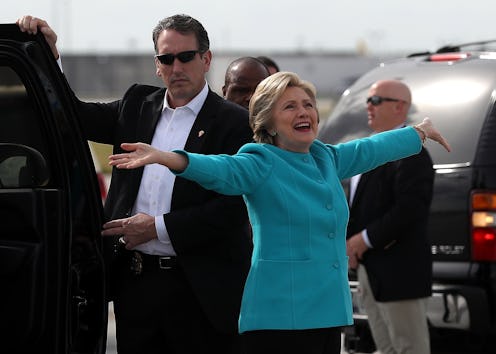News
Hillary Clinton's Wins Did Not Meet Expectations
It's hard to believe the presidential election is finally O-V-E-R. After more than a year of incessant coverage, ads, and debates, social media feeds across the country will return to discussions of really important issues, like recapping The Bachelor. In particular, this election was marked by a strengthening of the traditional concept of "red states" and "blue states." By the end of October, some analysts even considered Texas to be a true toss-up state. As the results poured in Tuesday night after more than 18 months of campaigning, Democratic nominee Hillary Clinton came out the winner in 21 states, and only four among those were hard-fought swing states.
Among the most traditional blue states are many places Clinton has lived. New York, Massachusetts, Connecticut, and Illinois were all listed by the New York Times as "almost certain" to go for Clinton; it was unsurprising to most, then, when each did. Virginia, normally a swing state, went to the former secretary of state, though it has seemed a clear Clinton prize for months — especially since her running mate, Tim Kaine, is the current senator and former governor of the state. However, after Virginia went her way, Clinton's big breaks for the night pretty much grounded to a halt.
Some states, like Michigan and Wisconsin, were labeled swing states but were widely assumed not to even be in play for Trump. When the returns started flowing in, though, Clinton supporters who had assumed that they had numerous paths to victory saw those options dwindling. Ohio, North Carolina, and Florida went for Trump first, and while Clinton was able to pick up victories out west in Colorado and New Mexico, this wasn't enough to stem the tide of electoral votes into Trump's column.
In the end, Trump picked up incredible gains for himself and his party. He got Pennsylvania's 20 electoral votes, the first time a Republican candidate had done that since George H.W. Bush in 1988. Michigan also hadn't voted for a Republican since 1988, but Trump changed that too. Wisconsin went red for the first time since 1984. With histories like that, it made perfect sense for the Clinton camp to assume that they would be safely on her side as well — but the polling turned out to have reflected a different reality. That combined with failures to pick up the states assumed to be more in question, like Florida and North Carolina, spelled doom for Clinton. What many had hoped would be a sweeping landslide victory for the first female candidate for president ended up the opposite — and now the Democrats will have their work cut out for them in the coming years.
